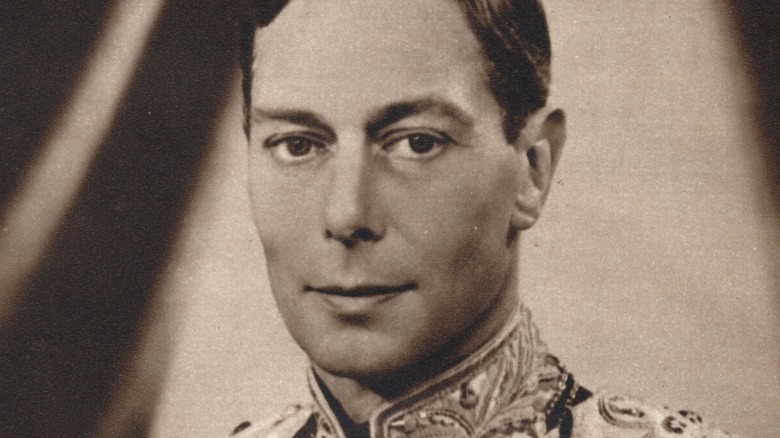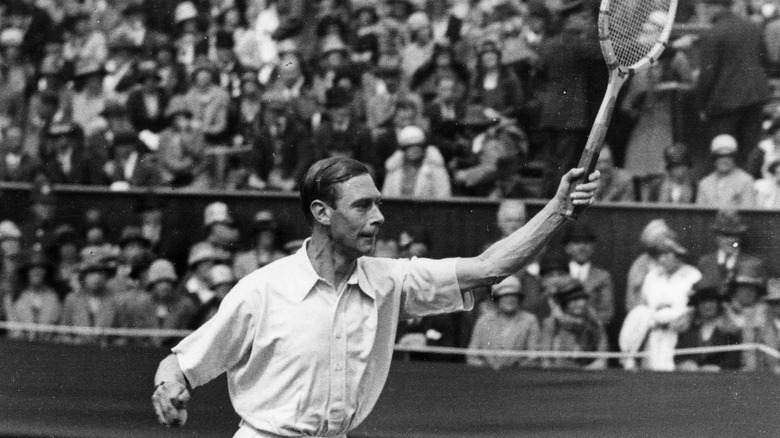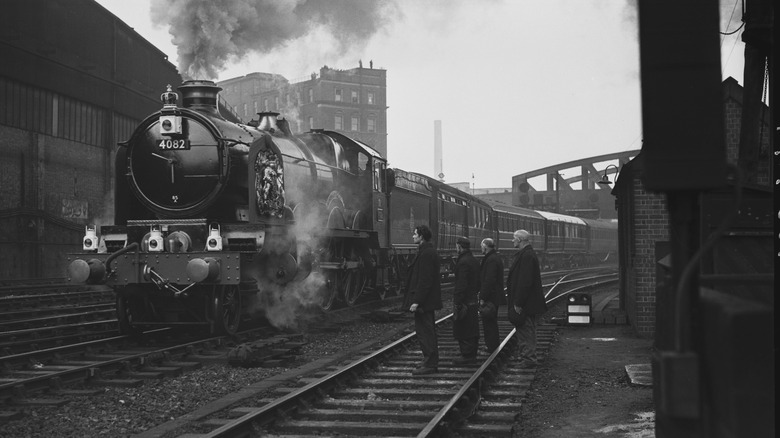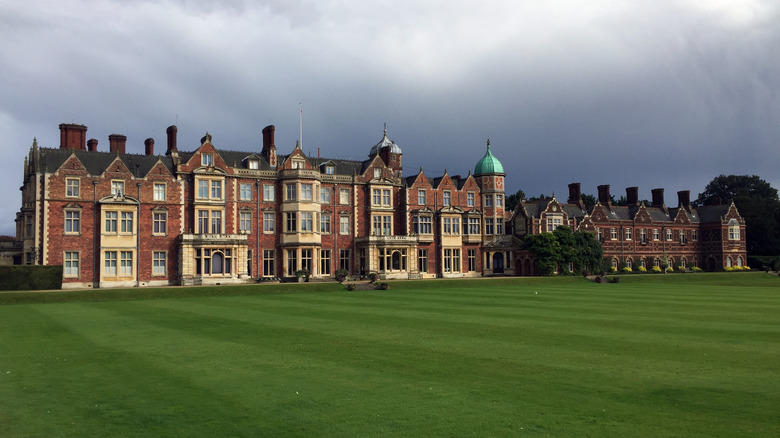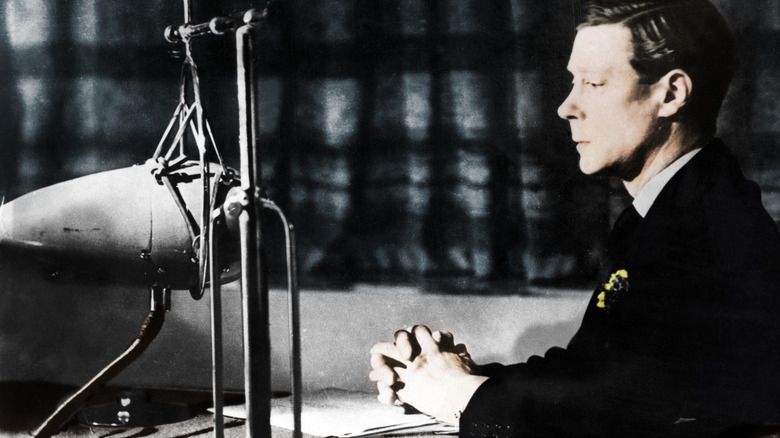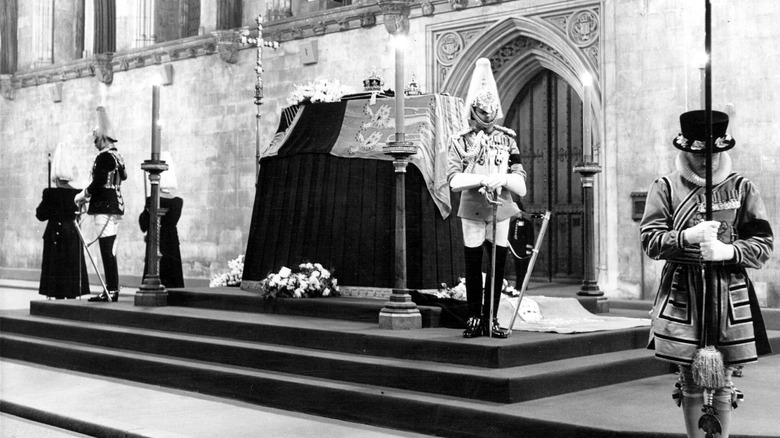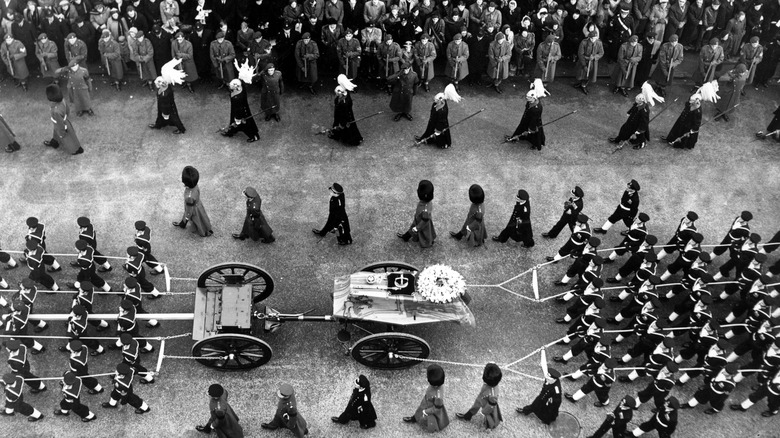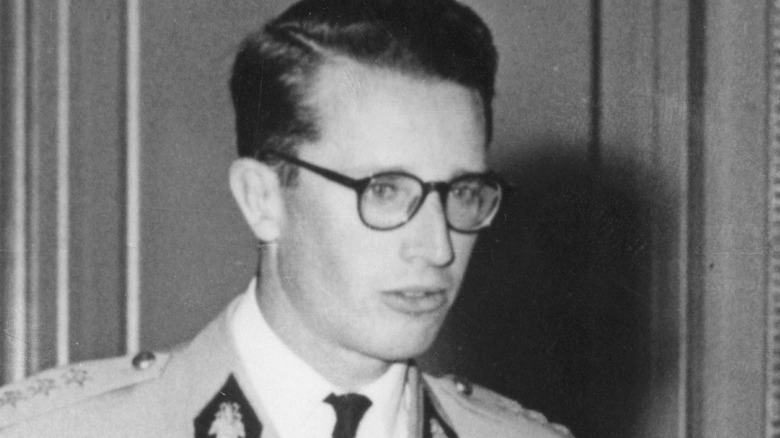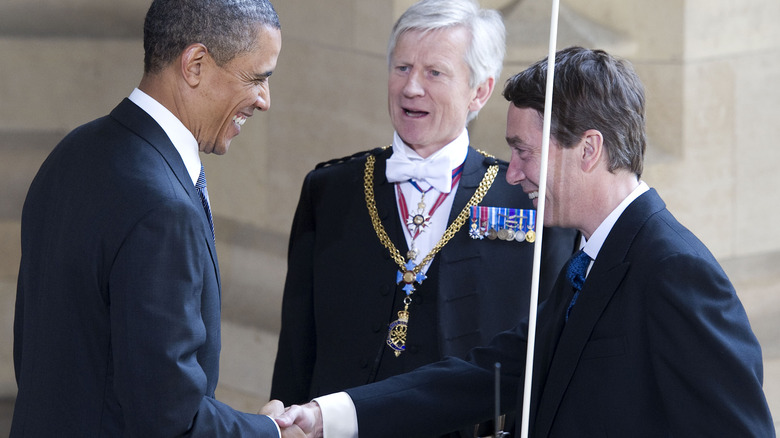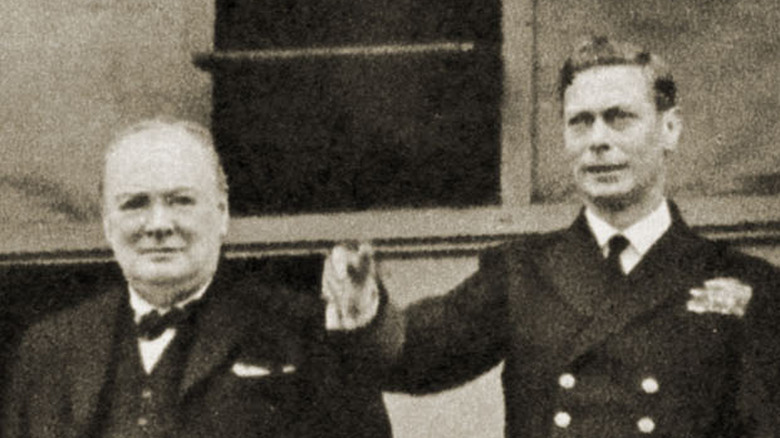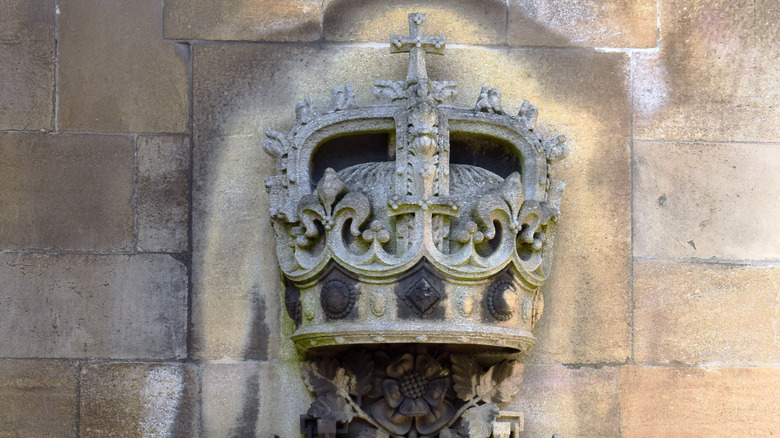The Untold Truth Of King George VI's Funeral
They may attract mockery at times, but the traditions and ceremonies of Britain's royal family are undeniably well-oiled bits of state and stagecraft. The State Opening of Parliament dates back to the 15th century, though many of its most iconic elements began during the 17th, according to the U.K. Parliament. The Ceremony of the Keys at the Tower of London has gone on for 700 years, and at least six ravens have been kept in the Tower since the reign of Charles II (per Reader's Digest).
These ceremonies and traditions relate to the monarch's role as head of state, or amount to quirks of history around its buildings. But in a monarchy, even private family events can become state functions. Royal weddings can be low-key affairs, or they can become international spectacles with their own associated customs (per the royal family's official website). And tradition follows the royal family even unto death.
Royal funerals are traditionally state affairs, at least when the deceased is the reigning sovereign, though the distinction between a state and ceremonial funeral is minor, according to The Independent. Even the latter can take on great import for the public; the Washington Post observed that Prince Philip's funeral was a powerful reminder of the comfort and order that such rituals can provide, particularly during such turbulent times as the COVID-19 pandemic. Until Queen Elizabeth II's death in 2022, a full state funeral for a monarch hadn't been seen since the death of King George VI in 1952.
The untimely but anticipated death
King George VI was only 56 when he passed away. Never meant to be sovereign, he reluctantly ascended the throne after the abdication of his brother, Edward VIII. During the course of his reign, this stuttering, anxious man became a beloved symbol of patriotism, determination, and resistance during World War II (per History Extra). His reserved and pious nature further endeared him to Britons; he oversaw the beginnings of the modern British Commonwealth, and he sat on the throne as the Cold War began (per the royal family's official website).
War, Britain's many woes at war's end, and family tensions (per Vanity Fair) all wounded the health of an already sickly monarch, and his incessant smoking didn't help any. George was visibly ill to visitors as early as 1949, and in 1951, his left lung was taken out due to "structural abnormalities." What the king really had was lung cancer, which Rolf F. Barth and L. Maximillian Buja suspect had already spread to his right lung in a paper for Cardiovascular Pathology (via PubMed).
George's family was told of his condition, according to History Today, but the king was not, nor was the general public. While he continued hacking up blood, George recovered from his surgery and left London for hunting in Sandringham early in 1952. He carried on in good spirits and retired to bed around 10:30 on February 5. The next morning, the king of Britain and the last emperor of India was found dead.
Hyde Park Corner
The British government has code words ready to communicate the death of the reigning sovereign. When Elizabeth II passed, the code word chosen was "London Bridge is down." For her father, George VI, the phrase was "Hyde Park Corner," for the junction near the royal park (per The Guardian). In the days before social media, easy leaks out of royal offices, and sophisticated telecommunications, these code words helped control the release of such news. George passed at his estate in Sandringham on February 5, 1952; "Hyde Park Corner" let the news be relayed to Buckingham Palace without alerting switchboard operators.
When the king's death became common knowledge, it was immediately marked. After repeating the announcement of George's death seven times every 15 minutes, the BBC went silent for five hours. The bells at St. Paul's Cathedral rang every minute for two hours to mark the death, while the Sebastopol bell at Westminster Abbey — reserved for monarchical death tolls — sounded 56 times for the king's 56 years.
Word also traveled to the realms of the Commonwealth, including British Kenya, where Elizabeth and Prince Philip were representing George on a royal tour the king was too sick to undertake. Per The Guardian, the princess was enjoying the local wildlife when her husband informed her of the king's death. While Elizabeth was quick to put on a face of duty and efficiency, passengers on the plane back to Britain saw her fresh from a cry over her father.
The people's tribute
Elizabeth II's favorite of the royal residences was Balmoral Castle in Scotland (per Reader's Digest). Her father and grandfather, Georges VI and V respectively, expressed a fondness for Sandringham House, the only other royal residence owned by the family. "I have always been happy here and I love the place," George VI wrote. It was to Sandringham he went after recovering from his surgery in 1951, and per History Today, it was at Sandringham that the king died.
George's body was always bound for London and a state funeral. But he had been a popular figure in the Norfolk countryside where Sandringham stands. He worshiped regularly at St. Mary Magdalene Church in the village; his body initially lay in rest there before setting out for the capital. Gaumont British News (via Reuters) produced a film on the procession of the coffin to the train station. The people of Sandringham, many working farmers or gamekeepers, lined the path to offer what Gaumont dubbed a "people's tribute" to the man taken as the local squire. Queen Elizabeth, Prince Philip, Elizabeth the Queen Mother, and the king's brother, the Duke of Gloucester, all traveled to Norfolk to take part in the send-off.
His brother came, with grudges
George VI was deeply mourned by his daughter, wife, and mother. Perhaps his brother David, the uncrowned Edward VIII, then Duke of Windsor, mourned as well. But family recollections saw little affection in the duke when he came to London for George's funeral. Biographer Alexander Larman told Vanity Fair that a "jaunty" Edward treated the funeral as if it were a chance to bask in public attention and photographers' flash bulbs, and History Today reports that he wasn't told of George's death by the family and griped about the loss of his allowance from the king.
If Edward was truly so self-absorbed during the funeral, it was only one of a lifetime of instances where the duke put himself before family, country, and crown. He and George, known as Bertie then, were close as children, despite markedly different personalities; Edward oozed charisma and easy charm, while George was reserved, dutiful, and awkward.
When it came time to assume the throne, however, Edward valued his relationship with the divorcée Wallis Simpson over his kingship, and spared little thought for the heavy responsibility he would leave his brother by abdicating. A firm believer in duty to Britain, George was aghast at his brother's disregard, and at his persistent demands for funds and a title for his wife after the abdication. Edward's sympathies and communications with the Third Reich made family relations impossible after World War II.
Football escaped mounting cancellations
The death of George VI was marked in different ways across the U.K. After announcing his passing, the BBC went silent for five hours. The bells at St. Paul's Cathedral and Westminster Abbey sounded. The House of Commons assembled to pay tribute and swear allegiance to Elizabeth II. And leisure activities across the country were rearranged or called off.
Per The Guardian, news coverage was given over to tributes and mourning. Somber music filled the airwaves. Cinemas closed, at least for one day, according to a photograph included in a retrospective by The Telegraph. As for sports, races and rugby and hockey matches were canceled. Curiously, an exception was made for football; four FA cup-ties went ahead, though the games were marked by the singing of "God Save the Queen" and the Christian hymn "Abide with Me" before kick-off.
Monarchs and monarchy aren't universally beloved, and even the sincerely bereaved can have their limits on displays of grief. The loss of leisure activities and the relentless signs of mourning took their toll on some Britons in 1952. An elderly woman asked the press: "Don't they think of old folk, sick people, invalids? It's been terrible for them, all this gloom." Another complaint was phrased in less caring terms; in Notting Hill, a fight broke out when a man in his cups dismissed the mourning by saying the king was "only s*** and soil now like anyone else."
Over 300,000 mourners paid their respects
George VI's coffin traveled from Sandringham to London on February 11, 1952 (per History Today), where it lay in state for three days at Westminster Hall. The coffin sat on a catafalque surrounded by guards, with the royal standard as a drape, according to the Royal Collection Trust. In that state, within that time, members of the public could pass through and pay their respects. Nor did they pass up the opportunity; over 300,000 mourners from around the U.K. came to the abbey to visit their departed king.
The state funeral was held on February 15, with the coffin borne from Westminster to Paddington Station for final burial at Windsor Castle. Thousands more came out to follow the procession, and thousands more watched the funeral on television for the first time in history (per the BBC). Units of all the armed forces took part in every stage of the funeral, as of course did his daughter, wife, son-in-law, and two brothers.
As head of state of a powerful nation, George was bound to receive tribute from his peers around the world. As king of Britain during World War II, when the British Empire still lingered, he was particularly honored. British Pathé produced a film of the funeral and noted some of the visiting dignitaries. Fellow monarchs from Denmark, Greece, Sweden, Norway, the Netherlands, and Iraq walked behind the coffin during the funeral, as did the president of France.
The absentee royal
Fellow royals from around the world came to play a part in George VI's funeral. The crowned heads of six nations marched in the procession according to British Pathé. But there was one notable absence from among the monarchs of Europe: Baudouin, King of the Belgians. He and George were related, albeit distantly, through the family of Queen Victoria (per Town and Country Magazine). But sharing blood and a vocation wasn't enough to offset the specter of World War II.
Baudouin's father, Leopold III, had assumed command over the Belgian armed forces when the Nazis invaded in 1940 but was forced into a quick surrender. Per Britannica, he was held prisoner for the remainder of the war. He was advised to go with the government into exile in London. By remaining behind — and by marrying a German woman, according to Time – he invited repudiation from his ministers, and an accusation from Winston Churchill of betraying the Allies. At the war's end, he lived in Switzerland while his brother Charles acted as regent. A narrow vote allowed his return to Belgium, but protests and strikes forced Leopold to abdicate in favor of Baudouin.
Leopold retained significant influence in the early part of his son's reign. Still resentful of Churchill's remark – and unaware that George didn't share the sentiment – he convinced Baudouin not to attend the funeral (per The Independent), a decision not popular among Belgians, according to the Canberra Times (via Trove).
Breaking the staff of office
The British monarchy is supported by the royal household, a body of officers dedicated to organizing ceremonial functions and maintaining the Royal Collection (per Britannica). Among them is the lord chamberlain, who serves as head of the body (also per Britannica). Appointed jointly by the prime minister and sovereign from among the peerage, the lord chamberlain's primary role relating to government is to convey messages to and from the sovereign and the House of Lords. As head of the royal household, they supervise all other offices responsible for supporting the monarchy's ceremonial functions, ranging from royal marriages to state visits. They also act as a counselor to the sovereign.
As a sign of their office, the lord chamberlain carries a white staff of silver (per Atlas Obscura) on ceremonial occasions. Upon the death of a sovereign, the current lord chamberlain breaks that staff — or rather, unscrews a joint in the middle — and places one half on the coffin during the funeral, a symbol of the end of authority for that monarch and that lord chamberlain, according to Allan Andrew Michie's "The Crown and the People." Such was done for the funeral of George VI in 1952.
Churchill's wreath - For Valour
George VI and Winston Churchill were not natural or immediate friends. Though they had similar upbringings, according to The Daily Beast, they grew into very different men — the king a shy, unhealthy, and retiring sort, Churchill an arrogant, oversized, and eccentric personality. While devoted to the institution of the monarchy, Churchill managed to offend two of George's predecessors. On the other hand, he had advised and supported Edward VIII when he attempted to marry Wallis Simpson, an act to which George, his wife Elizabeth, and most of the British public were opposed.
George was friendly with Neville Chamberlain, and when he was forced to resign after the disaster of appeasement, they hoped he would be succeeded by Lord Halifax. Churchill was difficult for him to accept as prime minister. But over the course of World War II, the two men built up a close and trusting partnership. The king — the one figure of state the prime minister was answerable to — could advise, counsel, and warn with total frankness. Churchill even bonded with Elizabeth, informing her of government matters when George was unavailable.
Their friendship continued after the war's end, through Churchill's brief stint in political exile from 1945 to 1951 and the king's declining health. On George's death, Churchill's secretary found him crying over the news. At the funeral, the prime minister offered a wreath on behalf of the government. The card read, "For Valour."
A tomb shared with royals ancient and modern
After his state funeral in London, George VI was borne by train from Paddington Station to Windsor Castle. There, per History Today, he was buried in St. George's Chapel. The church dates back to 1475, though it wasn't completed until 1528 under Henry VIII, according to i News. The Duke and Duchess of Sussex were wed there, as was Princess Eugenie. It was also the site of the funerals of Princess Margaret and the Queen Mother.
Edward IV, who began construction, is buried at St. George's. So were Henrys VI and VIII. Westminster Abbey has been the more popular final resting place for kings and queens, before and after St. George's was built; over 30 sovereigns lie there, according to the abbey's website. But the beheaded Charles I ended up at St. George's, and since the later Hanoverian kings, it has become an oft-used burial site. George III, George IV, William IV, Edward VII, and George V all proceeded George VI into the vaults.
Since the last George's death, a chapel within the chapel, the George VI Memorial, has been built, and he, his wife, and his daughter Margaret are all buried there. While the Duke of Edinburgh was initially interred in the royal vault of St. George's, it is intended that he be moved to the George VI memorial to join the family. And it is there that Elizabeth II will be laid to her final rest.
